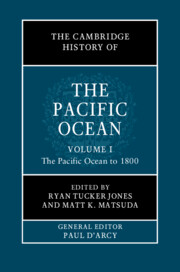Book contents
- The Cambridge History of the Pacific Ocean
- The Cambridge History of the Pacific Ocean
- The Cambridge History of the Pacific Ocean
- Copyright page
- Contents
- Figures
- Tables
- Contributors to Volume I
- Frontispiece
- General Editor’s Introduction
- Preface to Volume I
- Part I Rethinking the Pacific
- Part II Humans and the Natural World in the Pacific Ocean
- Part III Deep Time: Sources for the Ancient History of the Pacific
- Part IV The Initial Colonization of the Pacific
- Part V The Evolution of Pacific Communities
- Part VI Europe’s Maritime Expansion into the Pacific
- 28 Iberian Conceptions of the Pacific
- 29 Naval Rivalry in the Western Pacific: Portugal, England, Holland, and Koxinga, 1600–1720
- 30 The Resurgence of Chinese Mercantile Power in Maritime East Asia, 1500–1700
- 31 The Enduring Sea Cultures of Southeast Asia, Seventh–Seventeenth Centuries
- References to Volume I
- Index
28 - Iberian Conceptions of the Pacific
from Part VI - Europe’s Maritime Expansion into the Pacific
Published online by Cambridge University Press: 11 November 2022
- The Cambridge History of the Pacific Ocean
- The Cambridge History of the Pacific Ocean
- The Cambridge History of the Pacific Ocean
- Copyright page
- Contents
- Figures
- Tables
- Contributors to Volume I
- Frontispiece
- General Editor’s Introduction
- Preface to Volume I
- Part I Rethinking the Pacific
- Part II Humans and the Natural World in the Pacific Ocean
- Part III Deep Time: Sources for the Ancient History of the Pacific
- Part IV The Initial Colonization of the Pacific
- Part V The Evolution of Pacific Communities
- Part VI Europe’s Maritime Expansion into the Pacific
- 28 Iberian Conceptions of the Pacific
- 29 Naval Rivalry in the Western Pacific: Portugal, England, Holland, and Koxinga, 1600–1720
- 30 The Resurgence of Chinese Mercantile Power in Maritime East Asia, 1500–1700
- 31 The Enduring Sea Cultures of Southeast Asia, Seventh–Seventeenth Centuries
- References to Volume I
- Index
Summary
During the last decade of the twentieth century, Arif Dirlik took aim at the term ‘Spanish Lake’ for providing a historical shorthand to characterizing Euro-American conceptualization and penetration of the Pacific Ocean between the sixteenth and the twentieth centuries. Historically, according to Dirlik, the Pacific has been regarded as a succession of ‘lakes’ (or periods of hegemony) spanning a Spanish Lake (for the sixteenth to the seventeenth centuries), a British Lake (for the eighteenth to nineteenth centuries), and lastly an American Lake (spanning the nineteenth to the twentieth centuries).1 In his rendition Dirlik was inspired by the geographer Oskar Spate’s conception of the Pacific Ocean as a ‘European artifact’.2 Without seeking to denigrate the contributions of Asian and Pacific Islanders to this ocean, Spate argued that the Pacific became, for better or worse, integrated into human consciousness through European economic and cartographic imagination.Spate was one of the first to write extensively on the process of convergence in his trilogy The Pacific since Magellan.3 In his first volume, entitled The Spanish Lake, Spate borrowed and popularized a concept first introduced by the American historian William Schurz almost a century ago.4 Schurz, in preparation for his monograph on the Manila Galleon trade, provided an outline of the hegemony, more imaginary than real, that Castile exercised over the Pacific.5 John Gascoigne has recently recast Spate’s renditions in a less ethnocentric world historical framework by maintaining that the Pacific Ocean was last in the two global processes of divergence and convergence. It was one of the last areas to be settled by human beings and it was the last area to be fully integrated in the convergent process of globalization.6
- Type
- Chapter
- Information
- The Cambridge History of the Pacific Ocean , pp. 635 - 654Publisher: Cambridge University PressPrint publication year: 2023



